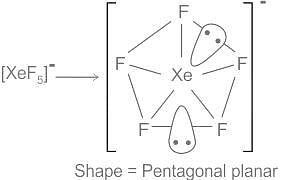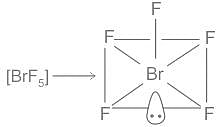UGC NET Exam > UGC NET Questions > Based on VSEPR theory, the predicted shapes o...
Start Learning for Free
Based on VSEPR theory, the predicted shapes of [XeF5]– and BrF5 respectively, are
- a)pentagonal planar and square pyramidal
- b)square pyramidal and trigonal bipyramidal
- c)trigonal bipyramidal and square pyramidal
- d)square pyramidal and pentagonal planar
Correct answer is option 'A'. Can you explain this answer?
Verified Answer
Based on VSEPR theory, the predicted shapes of [XeF5]– and BrF5 ...
[XeF5]–
- The central atom is 'Xe'.
- The electronic configuration of Xe (Z = 54) is = 1s2 2s2 2p6 3s2 3p6 3d10 4s2 4p6 4d10 5s2 5p6
- It is surrounded by five 'F' atoms and one electron.
- Total valence electrons
= 8+1
= 9
= 9
- Number of bonding pairs of electron = 5 and number of lone pairs of electrons = 2
- Hybridisation is sp3d3.
- Thus, the geometry of the molecule is Pentagonal bipyramidal.
- As the shape of the molecule can be predicted by excluding two lone pairs on the central atom and the Number of bonding pairs of electrons is 5, thus the shape of [XeF5]– is pentagonal-planar.

2. BrF5
- The central atom is 'Br'.
- The electronic configuration of Br (Z = 35) is = 1s2 2s2 2p6 3s2 3p6 4s2 3d10 4p5
- It is surrounded by five 'F' atoms.
- Number of valence electrons
= 5+2
= 7
= 7
- Number of bonding pairs of electron = 5 and
- number of lone pairs of electrons = 1
- Hybridisation is sp3d2.
- Thus, the geometry of the molecule is Octahedral.
- As the shape of the molecule can be predicted by excluding the lone pairs on the central atom and the Number of bonding pairs of electrons is 5, thus the shape of BrF5 is square pyramidal.

Hence, the predicted shapes of [XeF5]– and BrF5 respectively, are pentagonal planar and square pyramidal.
Most Upvoted Answer
Based on VSEPR theory, the predicted shapes of [XeF5]– and BrF5 ...
- **[XeF5]-**
**Shape:** Pentagonal planar
- **Explanation:**
In the case of [XeF5]-, the central xenon atom has 5 fluorine atoms attached to it. According to VSEPR theory, the xenon atom has 5 bonding pairs and 1 lone pair of electrons. This results in a pentagonal planar geometry, where the 5 fluorine atoms are arranged in a flat plane around the xenon atom.
- **Reasoning:**
The presence of 5 bonding pairs and 1 lone pair on the central atom leads to the formation of a pentagonal planar shape. The lone pair occupies more space compared to bonding pairs, causing the fluorine atoms to arrange themselves in a flat pentagon around the xenon atom.
- **BrF5**
**Shape:** Square pyramidal
- **Explanation:**
In the case of BrF5, the central bromine atom has 5 fluorine atoms attached to it. According to VSEPR theory, the bromine atom has 5 bonding pairs and 1 lone pair of electrons. This results in a square pyramidal geometry, where the 5 fluorine atoms are arranged in a square base with the lone pair occupying the apex of the pyramid.
- **Reasoning:**
The presence of 5 bonding pairs and 1 lone pair on the central atom leads to the formation of a square pyramidal shape. The lone pair occupies more space compared to bonding pairs, causing the fluorine atoms to arrange themselves in a square base with the lone pair at the apex of the pyramid.
**Shape:** Pentagonal planar
- **Explanation:**
In the case of [XeF5]-, the central xenon atom has 5 fluorine atoms attached to it. According to VSEPR theory, the xenon atom has 5 bonding pairs and 1 lone pair of electrons. This results in a pentagonal planar geometry, where the 5 fluorine atoms are arranged in a flat plane around the xenon atom.
- **Reasoning:**
The presence of 5 bonding pairs and 1 lone pair on the central atom leads to the formation of a pentagonal planar shape. The lone pair occupies more space compared to bonding pairs, causing the fluorine atoms to arrange themselves in a flat pentagon around the xenon atom.
- **BrF5**
**Shape:** Square pyramidal
- **Explanation:**
In the case of BrF5, the central bromine atom has 5 fluorine atoms attached to it. According to VSEPR theory, the bromine atom has 5 bonding pairs and 1 lone pair of electrons. This results in a square pyramidal geometry, where the 5 fluorine atoms are arranged in a square base with the lone pair occupying the apex of the pyramid.
- **Reasoning:**
The presence of 5 bonding pairs and 1 lone pair on the central atom leads to the formation of a square pyramidal shape. The lone pair occupies more space compared to bonding pairs, causing the fluorine atoms to arrange themselves in a square base with the lone pair at the apex of the pyramid.

|
Explore Courses for UGC NET exam
|

|
Similar UGC NET Doubts
Based on VSEPR theory, the predicted shapes of [XeF5]– and BrF5 respectively, area)pentagonal planar and square pyramidalb)square pyramidal and trigonal bipyramidalc)trigonal bipyramidal and square pyramidald)square pyramidal and pentagonal planarCorrect answer is option 'A'. Can you explain this answer?
Question Description
Based on VSEPR theory, the predicted shapes of [XeF5]– and BrF5 respectively, area)pentagonal planar and square pyramidalb)square pyramidal and trigonal bipyramidalc)trigonal bipyramidal and square pyramidald)square pyramidal and pentagonal planarCorrect answer is option 'A'. Can you explain this answer? for UGC NET 2025 is part of UGC NET preparation. The Question and answers have been prepared according to the UGC NET exam syllabus. Information about Based on VSEPR theory, the predicted shapes of [XeF5]– and BrF5 respectively, area)pentagonal planar and square pyramidalb)square pyramidal and trigonal bipyramidalc)trigonal bipyramidal and square pyramidald)square pyramidal and pentagonal planarCorrect answer is option 'A'. Can you explain this answer? covers all topics & solutions for UGC NET 2025 Exam. Find important definitions, questions, meanings, examples, exercises and tests below for Based on VSEPR theory, the predicted shapes of [XeF5]– and BrF5 respectively, area)pentagonal planar and square pyramidalb)square pyramidal and trigonal bipyramidalc)trigonal bipyramidal and square pyramidald)square pyramidal and pentagonal planarCorrect answer is option 'A'. Can you explain this answer?.
Based on VSEPR theory, the predicted shapes of [XeF5]– and BrF5 respectively, area)pentagonal planar and square pyramidalb)square pyramidal and trigonal bipyramidalc)trigonal bipyramidal and square pyramidald)square pyramidal and pentagonal planarCorrect answer is option 'A'. Can you explain this answer? for UGC NET 2025 is part of UGC NET preparation. The Question and answers have been prepared according to the UGC NET exam syllabus. Information about Based on VSEPR theory, the predicted shapes of [XeF5]– and BrF5 respectively, area)pentagonal planar and square pyramidalb)square pyramidal and trigonal bipyramidalc)trigonal bipyramidal and square pyramidald)square pyramidal and pentagonal planarCorrect answer is option 'A'. Can you explain this answer? covers all topics & solutions for UGC NET 2025 Exam. Find important definitions, questions, meanings, examples, exercises and tests below for Based on VSEPR theory, the predicted shapes of [XeF5]– and BrF5 respectively, area)pentagonal planar and square pyramidalb)square pyramidal and trigonal bipyramidalc)trigonal bipyramidal and square pyramidald)square pyramidal and pentagonal planarCorrect answer is option 'A'. Can you explain this answer?.
Solutions for Based on VSEPR theory, the predicted shapes of [XeF5]– and BrF5 respectively, area)pentagonal planar and square pyramidalb)square pyramidal and trigonal bipyramidalc)trigonal bipyramidal and square pyramidald)square pyramidal and pentagonal planarCorrect answer is option 'A'. Can you explain this answer? in English & in Hindi are available as part of our courses for UGC NET.
Download more important topics, notes, lectures and mock test series for UGC NET Exam by signing up for free.
Here you can find the meaning of Based on VSEPR theory, the predicted shapes of [XeF5]– and BrF5 respectively, area)pentagonal planar and square pyramidalb)square pyramidal and trigonal bipyramidalc)trigonal bipyramidal and square pyramidald)square pyramidal and pentagonal planarCorrect answer is option 'A'. Can you explain this answer? defined & explained in the simplest way possible. Besides giving the explanation of
Based on VSEPR theory, the predicted shapes of [XeF5]– and BrF5 respectively, area)pentagonal planar and square pyramidalb)square pyramidal and trigonal bipyramidalc)trigonal bipyramidal and square pyramidald)square pyramidal and pentagonal planarCorrect answer is option 'A'. Can you explain this answer?, a detailed solution for Based on VSEPR theory, the predicted shapes of [XeF5]– and BrF5 respectively, area)pentagonal planar and square pyramidalb)square pyramidal and trigonal bipyramidalc)trigonal bipyramidal and square pyramidald)square pyramidal and pentagonal planarCorrect answer is option 'A'. Can you explain this answer? has been provided alongside types of Based on VSEPR theory, the predicted shapes of [XeF5]– and BrF5 respectively, area)pentagonal planar and square pyramidalb)square pyramidal and trigonal bipyramidalc)trigonal bipyramidal and square pyramidald)square pyramidal and pentagonal planarCorrect answer is option 'A'. Can you explain this answer? theory, EduRev gives you an
ample number of questions to practice Based on VSEPR theory, the predicted shapes of [XeF5]– and BrF5 respectively, area)pentagonal planar and square pyramidalb)square pyramidal and trigonal bipyramidalc)trigonal bipyramidal and square pyramidald)square pyramidal and pentagonal planarCorrect answer is option 'A'. Can you explain this answer? tests, examples and also practice UGC NET tests.

|
Explore Courses for UGC NET exam
|

|
Signup for Free!
Signup to see your scores go up within 7 days! Learn & Practice with 1000+ FREE Notes, Videos & Tests.
























